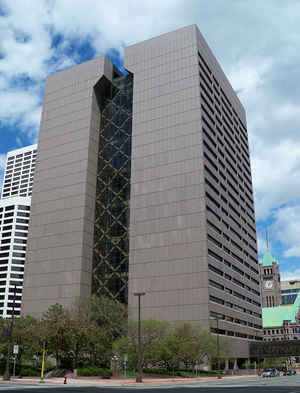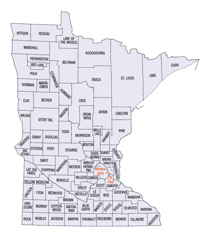Minnesota Counties
There are eighty-seven Counties in Minnesota. On October 27, 1849 nine large Minnesota Counties were created. Among them were Benton, Dahkotah, Itasca, Ramsey, Mahkahta, Pembina, Wabashaw, Washington, and Wahnata. Of those Benton, Dakota, Itasca, Ramsey, Wabasha, and Washington still exist as their original name. With the creation of Kittson County on March 9, 1878, Pembina County no longer existed. When Minnesota was organized as a state, 57 of the present 87 Counties were established. The last county to be created was Lake of the Woods County in 1923Hennepin County, Minnesota
Hennepin County Education, Geography, and History
Hennepin County is a county located in the state of Minnesota. Based on the 2010 census, the population was 1,152,425. It is the most
populous county in Minnesota and the 34th-most populous county in the United States; more than one in five Minnesotans live in Hennepin
County. Its county seat is Minneapolis, the most populous city in the state. The county is named in honor of the 17th-century explorer Father
Louis Hennepin.
Hennepin County is included in the Minneapolis-St. Paul-Bloomington, MN-WI Metropolitan Statistical Area
Etymology - Origin of Hennepin County Name
Named for Louis Hennepin, Franciscan missionary, author and explorer. Explored large section of Mississippi River and named Falls of St. Anthony, 1680
Demographics:
County QuickFacts: CensusBureau Quick Facts
Hennepin County History
Hennepin County was created in 1852 by the Minnesota Territorial Legislature. Father Louis Hennepin's name was chosen because he originally named St. Anthony Falls and recorded some of the earliest accounts of the area for the Western world. Hennepin County's early history is closely linked to the establishment of the cities of Minneapolis and St. Anthony
Geography: Land and Water
As reported by the Census Bureau, the county has a total area of 607 square miles (1,570 km2), of which 554 square miles (1,430 km2) is
land and 53 square miles (140 km2) (8.7%) is water. Hennepin is one of 17 Minnesota counties with more savanna soils than either prairie or
forest soils, and is one of only two Minnesota counties with more than 75% of its area in savanna soils (the other is Wright County).
The highest waterfall on the Mississippi River, the Saint Anthony Falls, discovered by Louis Hennepin, is in Hennepin County next to downtown
Minneapolis, but in the 19th century, the falls were converted to a series of dams. Barges and boats now pass through locks to move between
the parts of the river above and below the dams.
Neighboring Counties
Bordering counties are as follows:
- Anoka County (northeast)
- Ramsey County (east)
- Dakota County (southeast)
- Scott County (south)
- Carver County (southwest)
- Wright County (northwest)
Education
Colleges and universities in the county include:
Augsburg College in Minneapolis
Dunwoody College of Technology in downtown Minneapolis
Hennepin Technical College in Brooklyn Park and Eden Prairie
Metropolitan State University in downtown Minneapolis and Brooklyn Park
Minneapolis College of Art and Design in Minneapolis
Minneapolis Community and Technical College in downtown Minneapolis
Minnesota State University, Mankato in Edina
Normandale Community College in Bloomington
North Central University in downtown Minneapolis
North Hennepin Community College in Brooklyn Park
Northwestern Health Sciences University in Bloomington
Saint Mary's University of Minnesota, Twin Cities Campus in South Minneapolis
University of Minnesota, Twin Cities Campus in Minneapolis
University of St. Thomas Minneapolis Campus in downtown Minneapolis







